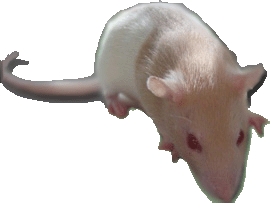








You are visitor number..................... since WFR's website launch on March 5th 2005.
If you wish to use any material from our site, please be polite and email us for permission. warmfuzziesrattery@yahoo.com.au


![]()
Here are a list of articles from breeders around the globe that we have found most useful in guiding us towards good breeding practices. These are must reads for people who are thinking about starting up a rattery, or people like us, who have found new direction from their experience and ethical breeding methods.
Breeding: Can YOU Live With It? by Mary Ann Isaksen ratfanclub.org (USA)
Breeding Information by Vickie Boutwell of Curiosity Rats (USA)
Selective Breeding by Vickie Boutwell of Curiosity Rats (USA)
Reason For Breeding by Alison Campbell of Shunamite Rats (UK)
Choosing Rats To Breed by Alison Campbell of Shunamite Rats (UK)
Information On Breeding by Elisebeth Brooks of Spoiled Ratten Rattery (USA)
Outcrossing, Linebreeding & Inbreeding Rats by Elisebeth Brooks of Spoiled Ratten Rattery (USA)
Inbreeding Is Essential by Yvette Mackail of Carawatha Rodents (AUS)
A Responsible Breeders "Code Of Ethics" by Nichole Royer AFRMA (USA)
Our long term breeding goals, listed by priority:
Temperament: This is the first thing we look at when deciding if a rat has breeding potential. We love rats that are inquisitive, friendly, outgoing and are interested in being with people. I will always choose the pup with the best personality over the pup with the better markings. If a rat is fantastic with people, but is aggressive towards other rats, they won't be included in our breeding plans. If they are overly nervous, very shy or are biters, they won't be bred, even if they're perfectly healthy, beautiful rats otherwise. This would only be working backwards from our goals.
Health: We will only choose rats that have shown resistance to Myco and other diseases, are not easily stressed and are allergy free. Any lines that have shown a high tendency for early tumors, or carry defective genes will be discontinued. As we've only been breeding for a short period, we don't have a complete database of any cancer or disease related illness, but we are keeping records of the lines we intend to breed from, and will be utilizing the database for all future family lines. This includes recording longevity, age tumors were present, type and placement of tumors, any minor sickness, any birthing problems, everything.
Conformation: Something that we hold over colour and pattern, and feel that it is often overlooked for the sake of breeding the "fancier" varieties. We will breed for short, broad heads on the bucks, femininely balanced heads for does, big round eyes, big rounded ears, a solid build for bucks with a nice arch to the back, a lean and muscular build for does and long strong tails. We will not be breeding animals that have too many faults, be it poor muscle tone, short tails, small eyes, long pointy heads or even thin or oily fur. If a rats other qualities shine, and there is one minor fault that can be improved on by "breeding up", then it may be considered for breeding.
Variety: While we do keep this in mind for planning our lines, coat type, colour and markings are always last on the checklist for choosing potential breeders. We do have preference for what varieties we will be breeding, and will be working on and documenting several family lines as we go. Here they are in no particular order:
~ Rexes in mostly Cinnamon and Mink, Hooded, Berkshire and Capped. Other colours and markings will be introduced as we go. Rexes typically are nice solid, "squishy" rats. Our rexes are my favourite rattie family line. They have outgoing, friendly personalities, with the males tending to be cuddlier, and the females very clever and inquisitive shoulder rats, they just love to be with you.We also have a line dedicated to producing longer coated Rexes, using Silky and Carasilk coat types.
~ Blazes in Agouti, Cinnamon, Black, Mink, Variegated Berkshire, Hooded & Capped markings. This will be a slow process, as the recessive spotting gene we have in Australia is proving difficult to reproduce. Blazes in general have very poor conformation, something we hope to improve with our breeding plans by introducing "boofy" Rex rats to the line. **Update: We have recently aquired 3 lovely blazed rats from Ron in Maitland. These are the best Blazed rats I have come across yet, in both temperament and conformation. I'm very excited to start working with these genes, but as they have very little background history, the boys will have to wait until they're 10+ months to be mated.
~ Down Unders in most colours, Variegated and Spotted markings, all coat types. DU's generally don't have great type, and aren't the squishy lap rats that we all love, tending to be hyper and curious little monkey rats. But as the marking is a dominant trait, this should prove easier to work on than the Blazes. All DU's will be to pet only homes, unless otherwise arranged, due to the fact that they can carry defective genes. Though we will only be working with proven DU lines to decrease the chance of these defects occuring.
We will be focusing our attention on these particular varieties, but will most likely have other colours and markings involved along the way. All of our lines are a constant work in progress, we are dedicated to our long term goals and though we may get to a stage where we're satisfied with our lines, we will never be 'finished' improving on them.We will only be breeding around 6 litters a year. Our goals will take time and patience to do it right. We do not make any money from breeding and adopting out our rats, we spend much more on them every month than we could ever make back. We do it because we want to improve the pets that we've come to love and respect for the amazing creatures they are.
